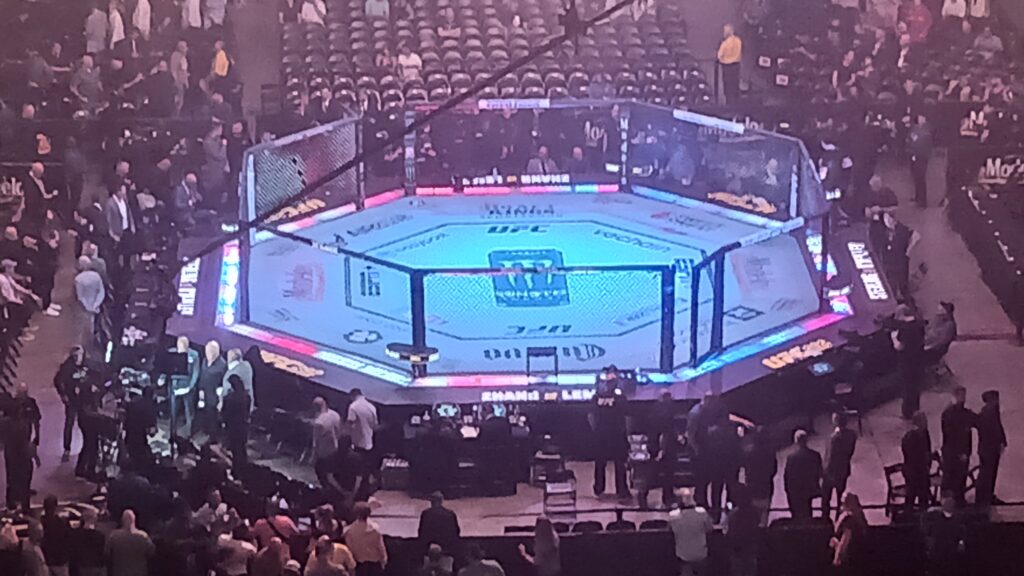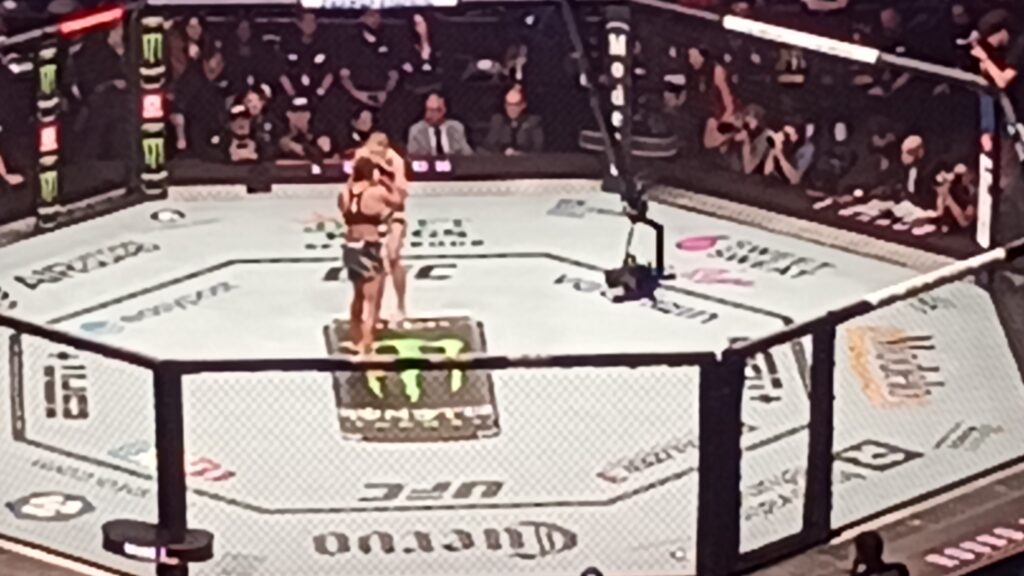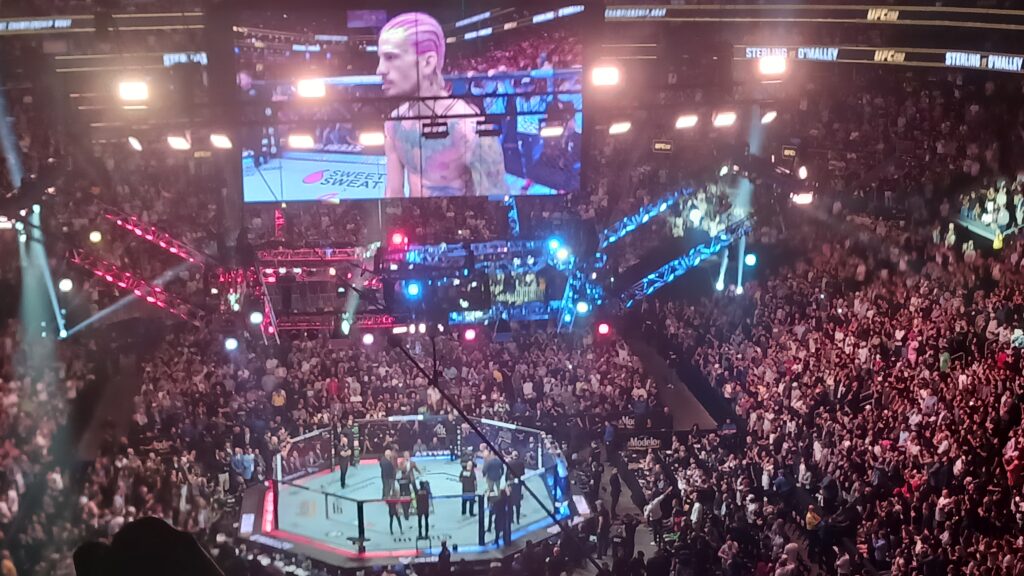By: Rich Bergeron




UFC 292 was the first UFC event I attended in 16 years. As the MMA writer most known for exposing the Xyience scandal (see www.xyiencesucks.com), I dug out my old Xyience hat to commemorate the occasion. Once the UFC’s most prolific sponsor, Xyience is now primarily an energy drink company and does not even associate with any MMA league anymore. Needless to say, I was the only one in the entire arena sporting Xyience merch.
I paid for my own tickets this time, but I couldn’t avoid thinking about what my UFC 292 experience would have been like if my UFC 78 experience, paid for by Xyience, had turned out much differently for me almost 16 years ago.
I will be ruminating more on the personal story of my own Boston homecoming and the changes we’ve seen for the UFC between the last fight I attended and this one in a new piece I plan to write on www.paythefighters.com. Stay tuned for that, but first let’s get to the UFC’s well constructed fight card for Saturday night.
It began with a tale of two flyweight Silvas: Karine Silva and Natalia Silva. Those bouts ended with two Silva wins by two different methods, but each fighter proved dominant in their particular styles. Karine dispatched Maryna Moroz with a last-second guillotine choke just before the end of the first round. It was a fantastic start to a show that had a few peaks and valleys as far as the entertainment value of some of the match-ups. Natalia took her time and picked apart a game Andrea Lee from a distance for the majority of the contest. She cruised to a unanimous decision by being cautious and careful with her striking aim.
Next, a controversial split decision gave the odds-makers’ favorite fighter Andre Petrovski a win over Gerald Meershaert. Petrovski did not appear to have the cardio to hang with the seasoned veteran Meerschaert. All that was lacking in this fight was the concentrated striking power from Meershaert to put Petrovski down and out. Both fighters had their moments, but it seemed obvious to me Gerald was the busier and more effective fighter. He was only one of the robbery victims accosted by the judges Saturday night after clearly winning a primarily technical fight. The touches of slugfest sprinkled in from time to time seemed to always favor the more game and eager Meerschaert. He definitely deserved the win. We’ll talk about another robbery of equal caliber a bit later.
A pair of Ultimate Fighter Finale fights came next with Bantamweights Brad Katona and Cody Gibson kicking it off by earning “Fight of the Night” honors. Their toe-to-toe kickboxing match that rarely hit the ground for very long certainly had the crowd riled up from start to finish. Katona ended up being a second quicker on the draw and sharp enough with his jabs and counters to secure a win in a scrap where he often had to take one good punch to land two of his own. Gibson wore the results of Brad’s accuracy on his battered face at the final bell, but he also earned great respect for his never-quit approach from both the crowd and the organization. The UFC offered both fighters contracts for their efforts instead of only the winner getting the nod.
Kurt Holobaugh had to fight friend and fellow Team Chandler fighter Austin Hubbard in the Lightweight finale. It was a fight that started better for Hubbard than it ended. Eventually after a short feeling out process, Holobaugh took the momentum away and secured a phenomenal Triangle Choke just 2:39 into the second frame. Both fighters had their dominating moments, but it was Holobaugh’s black belt jiu jitsu skills that won the night and the TUF trophy.
Gregory Rodrigues absolutely demolished Russian Dennis Tiuliulin in a middleweight fight that had the Beantown crowd chanting “USA” briefly while rooting for a Brazilian fighter. “Robocop” enjoyed the crowd support and quickly obliged their cheers with his finishing skills in full display. Rodrigues coincidentally looks a bit like the main character in Netflix’s “The Lincoln Lawyer,” if the character bulked up after a few rounds of steroids. Rodrigues certainly laid down the law and pummeled the Russian into unconsciousness with a machine-like precision. He took just one minute and 43 seconds to give the crowd their last stoppage until the main event.
Five straight decisions followed, two of them decided by perfect placement of monstrous leg kicks from the victors. The most painful of those two bouts to watch was Chris Weidman finishing out the preliminaries by facing off with Brad Tavares in a punishing middleweight battle. Weidman, coming back from a vicious rubber chicken leg injury where he tried to plant on a completely broken leg against Uriah Hall, looked rusty as rusty can be. Every takedown he attempted seemed to get stuffed easily by Tavares.
Every punching exchange seemed to be too little, too late for Weidman to come back from the constant leg kicks peppering both the leg with the old injury and Weidman’s other leg for good measure. Even with a torn MCL or ACL (according to Dana White who compelled Weidman to retire after the fight), Weidman stalked Tavares around the cage and tried his best to take the fight to him despite the busted wheel. Tavares won a very strategic and smart fight, disappointing the entire pro-Weidman crowd hoping for that miracle comeback performance that never came.
Marlon “Chito” Vera and Pedro Munhoz opened up the main card with a one-sided affair showcasing Vera’s patience, striking acumen, and nearly-flawless technique. Munhoz finished the fight on his feet, but he endured plenty of facial damage getting there. Chito stayed at a safe range for the majority of the bout and took few risks on the way to his unanimous decision win. The reach and speed of Vera seemed to be the most effective advantages he enjoyed against the shorter and stockier Munhoz. Vera, boring as he may be to watch at times, proved he deserves his own bantamweight title shot.
The third-straight decision gave Mario Bautista a very controversial unanimous decision win over Da’Mon Blackshear. Bautista edged out Blackshear in terms of ground control, but Blackshear was more accurate in his striking and landed more significant strikes in the featherweight scrap. I certainly thought he did enough to win, but the judges did not see the fight the same way and gave the contest to Bautista.
Ian Garry and Neil Magny clashed next in a mismatched welterweight contest. Magny showed tremendous heart in getting back up after every knockdown, but he could not overcome the incessant leg kicks thrown by Garry. Referee Keith Peterson came close to stopping the bout a few times, but Magny kept doing just enough to keep it going, hopping around on one leg at times. Garry’s striking was just as on point as his trash talk game, evoking the spirit of Nate Diaz with a few well-timed hand gestures. The crowd celebrated his continued dominance with Garry telling them about his desire to be the best fighter on the face of the earth someday in his post-fight speech. Magny will have to find an answer to his recent struggles if he wants to remain relevant in the UFC.
Weili Zhang and Amanda Lemos squared off in an epic title fight next. Lemos nearly secured a couple miraculous submission attempts, but the strawweight title fight turned into a question of whether or not Lemos could survive until the final bell. Zhang showcased her talents in all her areas of expertise, and Lemos could only hope to win by way of a couple Hail Mary submission attempts Zhang wriggled out of. Zhang’s speed, power and durability overwhelmed Lemos and left her struggling to avoid a stoppage through much of the later rounds. Somehow she managed to do it, taking a tremendous amount of damage on her way. Zhang walked away retaining her title, much to the delight of fans who backed her through the entire fight.
Finally, the main event arrived, well after midnight. Sean O’Malley entered the arena first, and the crowd erupted. Many of them sported green or pink wigs to imitate O’Malley’s signature look. O’Malley honestly looked pretty petrified, as if he didn’t even sleep at all the night before the event. Aljamain Sterling entered the cage to a chorus of boos he attempted to make light of by egging the crowd on to boo him more.
The first round was mostly a showcase of footwork from both fighters. O’Malley’s head games might have worked on Sterling, because he promised in pre-fight interviews he would secure a first round TKO of his own. Rather than rely on his greatest strength, his wrestling, Sterling wanted to beat O’Malley at his own game. That turned out to be the wrong strategy, a fact Sterling eventually realized by the time he ended up on the wrong side of that TKO. There were scant attempts to take O’Malley down, and all of them were completely stuffed. Sterling folded and fell to the canvas after getting hit with an O’Malley counter punch early in the second round. The rest was history as O’Malley closed “the Suga show” with some McGregor-esque ground and pound.
Both fighters gave great post-fight speeches, true to form. Sterling was gracious in defeat and showed his respect for O’Malley striving to reach his dream. Considering Sterling criticized O’Malley before the fight for being Dana White’s pet project and not deserving a title shot, it was a huge mea culpa. Also, if it was indeed all about being favored by Mr. White, O’Malley might have ticked off the Baldfather by indicating he’d like to fight Boxer Gervonta Davis more than any other actual UFC fighter.
As only the second Dana White Contender Series fighter to earn a world title, O’Malley can certainly call his own shots to some extent, but a boxing crossover is a very sensitive subject in the wake of Francis Ngannou recently making waves for backing out of his UFC contract and signing up for a heavyweight boxing match with Tyson Fury that will eclipse his career UFC earnings by a mile. Only Conor McGregor has been able to convince UFC brass to go all in on a crossover fight into boxing so far. Dana White has since completely scrapped tentative plans to create “Zuffa Boxing” to account for his fighters wanting to emulate McGregor’s profile, financial track record and bold bravado that earned him that opportunity to fight Floyd Mayweather in an exhibition bout.
Often, to get Dana White’s attention and respect, fighters simply have to sell themselves enough for that to translate into massive merchandise and ticket sales generated off their buzz. Much like the WWE, big personas and colorful characters often win out on opportunities in the UFC over athletes who just concentrate on their physical skill sets. Strikers are especially favored, because they deliver on the UFC’s implied “put on a show” standard of excellence imposed on every fighter who steps into the cage. It’s a style of management and carrot and stick leadership that fools fighters into thinking it’s better for their careers to constantly come forward with little concern for defense and take tremendous risks to be much more exciting and entertaining than they need to be to win a particular fight.
Now this kid O’Malley confesses to want to be like Dana himself, comfortable enough financially to bet $250,000 per poker hand. The most special talent prior to O’Malley used his own rising star persona to build his own name brands and buy his own whiskey company. He has a yacht and a Lamborghini, and he’s still the most talked about and called out fighter in the organization even after losing such a one-sided battle with Dustin Poirier and being sidelined with a broken leg for a few years. The fact that O’Malley can realize and internalize that he’ll probably never get to Conor’s level without a huge crossover fight in boxing speaks volumes about where the UFC is at today.
It is the kind of development I have to chuckle at knowing how hard it’s been to bring all the fighter pay and contract issues to court without an army of lawyers to face the UFC’s formidable legal team. One such legal army recently secured the go ahead to pursue a class action anti-trust lawsuit on behalf of over 1,200 former UFC fighters. The judge in the case appears to be already siding with the plaintiffs. Reaction to UFC class-action lawsuit certification: What happened, and what’s next? (msn.com)
Whenever the organization is confronted by statistics that show the revenue share for fighters is minuscule compared to other major sports with players’ associations, the response is typically something to the effect of: “We’ve made so many millionaires. Our fighters are doing just fine, and they all get plenty of financial opportunities with the fame we’ve helped them achieve.”
As an expert on the UFC’s financial history and an audience member at UFC 292, I couldn’t avoid confronting the reality that so many “UFC Nut-hugger” journalists get all the fringe benefits of press privileges because they play along so well with that “Zuffa Myth” mentality. The folks who put the UFC on the map subliminally seduce their supporters with access and promises of fame and opportunity, and fighters and media members alike get sucked into those kind of management theatrics. In turn, you don’t end up with much investigative reporting in MMA media circles, and fighters who ask a lot of questions and demand better contract conditions don’t get re-signed or set up with prime fight match-ups.
It took the main event result to really clarify the issue for me of how the UFC constantly keeps the focus on their supposed ability to create superstars just by letting a fighter sign any contract with the organization. Some who agree that’s the case would say it was the organization’s ability to see enough talent in O’Malley to put him on Dana White’s Contender Series that led to the spectacular rise to fame the new champ’s riding. Certainly, O’Malley wouldn’t have even been in Boston Saturday night if he never got into the organization. However, there have been plenty of DWCS fighters who didn’t get any more UFC opportunities because they lost that entry-level fight. O’Malley had to win and keep winning to be where he was on Saturday night.
The point is: Sean O’Malley’s cult following and tremendous self-confidence is a result of his own personal crusade to be someone special with unlimited potential and amazing talent. He would never even be in the conversation for a title if he did not put in all the untold hours in the gym striving to be better. The UFC did not create Sean O’Malley, they just gave him a platform to show what kind of fighter he could be. And while he is enjoying the superstardom the UFC will credit themselves for, O’Malley has to know the only way he can maximize his earning potential is to eclipse the organization itself. He has to go above and beyond their restrictive financial borders to a sport where the revenue share is so much better and a guy like Francis Ngannou can make more in one fight than he made in his entire UFC career.
So, If Dana White really did make Sean O’Malley his pet project as Aljamain Sterling suggested, he did a great job. Unfortunately, the monster he created may come back to bite him in the long run. Another UFC co-promoted boxing card will get too many of their employees trying to take the same route and wondering why Dana’s little buddy is getting all the breaks and benefits. Veterans and newcomers will both likely look at any hyped up Davis vs. O’Malley boxing match as an admission by their leadership that the UFC can’t pay their fighters enough to keep them in the cage.
“Kid, you have no idea how much money you’re gonna to make,” Dana White told O’Malley after the win according to a recent O’Malley interview. I imagine in his head, Dana finished that thought with “us.”
